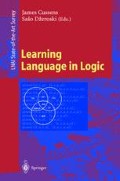Abstract
In this chapter we describe an approach to grammar induction based on categorial grammars: the EMILE algorithm. Categorial grammars are equivalent to context-free grammars. They were introduced by Ajduciewicz and formalised by Lambek. Technically they can be seen as a variant of the propositional calculus without structural rules. Various learnability results for categorial grammars are known. There exists a whole landscape of these so called substructural logics. This suggests an extension of the ILP research program in the direction of what one might call substructural ILP. We discuss the application of substructural logic to database design and present some complexity results from the literature that suggest the feasibility of this approach.
Access this chapter
Tax calculation will be finalised at checkout
Purchases are for personal use only
Preview
Unable to display preview. Download preview PDF.
References
Aarts, E. (1995). Investigations in Logic, Language and Computation. Ph.D. thesis, University of Utrecht.
Adriaans, P. (1990). Categoriale modellen voor kennissystemen. Informatie, 118–126.
Adriaans, P. (1992). Language learning from a categorial perspective. Academisch proefschrift, Universiteit van Amsterdam.
Adriaans, P. (1999). Learning Shallow Context-Free languages under simple distributions. CSLI-publications, University of Stanford.
Adriaans, P., & de Haas, E. (2000). Substructural PAC learning. Research report, Syllogic.
Ajdukiewicz, K. (1935). Die syntactische konnexität. Studia Philosophica, 1, 1–27.
Andreka, H., van Benthem, J., & Nemeti, I. (1996). Modal languages and bounded fragments of predicate logic. Pre-print ML-96-03, ILLC, Amsterdam.
Apt, K., & Pellegrini, A. (1994). On the occur-check free Prolog programs. ACM Toplas, 16 (3), 687–726.
Chagrov, A., & Zakharyaschev, M. (1996). Modal Logic. Oxford University Press.
de Haas, E. (1995). Categorial graphs. In Reichel, H. (Ed.), Fundamentals of Computation Theory, FCT’95, Vol. 965 of LNCS, pp. 263–272. Springer.
de Haas, E. (2000). Categories for Profit. Ph.D. thesis, Universiteit van Amsterdam. In preparation.
E.Y., S. (1984). Alternation and the computational complexity of logic programs. Journal of Logic Programming, 1, 19–33.
Fowler, M. (1997). UML Distilled: Applying the Standard Object Modeling Language. Addison Wesley Longman.
Fujinami, T. (1997). A decidable linear logic for transforming DRSs in context. In Dekker, P., S. M. V. Y. (Ed.), Proceedings of the 11th Amsterdam Colloquium, pp. 127–132.
Gurevich, Y. (1988). Logic and the challenge of computer science. In Boerger, E. (Ed.), Trends in Theoretical Computer Science, pp. 1–57. Computer Science Press.
Kanazawa, M. (1994). Learnable Classes of Categorial Grammars. Ph.D. thesis, University of Stanford.
Kanovich, M. (1992). Horn programming in linear logic is NP-complete. In Proc. 7th annual IEEE symposium on Logic in Computer Science, pp. 200–210 Santa Cruz, CA. Full paper appears in Annals of Pure and Applied Logic.
Lambek, J. (1958). The mathemetics of sentence structure. American Mathematical Monthly, 65, 154–169.
Lambek, J. (1990). Logic without structural rules. Another look at cut elimination. Ms. McGill University, Montreal.
Lincoln, P., Mitchell, J., Scedrov, A., & Shankar, N. (1992). Decision problems for propositional linear logic. Annals of Pure and Applied Logic, 56, 239–311.
Lincoln, P., S. N. (1994). Proof search in first order linear logic and other cut-free sequent calculi. In Proc. of the ninth (IEEE) symposium on Logic in Computer Science, pp. 282–291.
Oehrle, R.T., B. E. W. D. (Ed.). (1988). Categorial Grammars and Natural Language Structures. D. Reidel Publishing Company, Dordrecht.
OMG, http://www.omg.org (1997). UML 1.1 Specification. documents ad970802-ad0809.
Pentus, M. (1993). Lambek grammars are context free. In IEEE Symposium on Logic in Computer Science.
Scedrov, A. (1995). Linear logic and computation: A survey. In Schwichtenberg, S. (Ed.), Proc. of the 1993 Summer School at Marktoberdorf, Germany, No. 139 in Ser. F. Commut. System Sci., pp. 379–395. Springer Verlag. also as Report Dept. of Mathematics, University of Pensylvania, 1993.
Schroeder-Heister, P., D. K. (1993). Substructural Logics. Oxford University Press.
Troelstra, A. (1992). Lectures on Linear Logic. No. 29 in Lecture Notes. CSLI, Stanford.
Valiant, L. (1984). A theory of the learnable. Communications of the ACM, 27 (11), 1134–1142.
Author information
Authors and Affiliations
Editor information
Editors and Affiliations
Rights and permissions
Copyright information
© 2000 Springer-Verlag Berlin Heidelberg
About this chapter
Cite this chapter
Adriaans, P., de Haas, E. (2000). Grammar Induction as Substructural Inductive Logic Programming. In: Cussens, J., Džeroski, S. (eds) Learning Language in Logic. LLL 1999. Lecture Notes in Computer Science(), vol 1925. Springer, Berlin, Heidelberg. https://doi.org/10.1007/3-540-40030-3_8
Download citation
DOI: https://doi.org/10.1007/3-540-40030-3_8
Published:
Publisher Name: Springer, Berlin, Heidelberg
Print ISBN: 978-3-540-41145-1
Online ISBN: 978-3-540-40030-1
eBook Packages: Springer Book Archive

